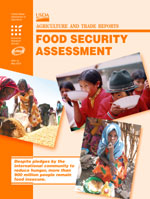Food Security Assessment, GFA-15
- by Stacey Rosen, Shahla Shapouri, Birgit Meade, Michael Trueblood, William M. Liefert and Constanza Valdes
- 5/20/2004
Overview
Just over 900 million people in the 70 low-income countries studied in this report are estimated to have consumed less than the recommended nutritional requirements in 2003. This marks a decline from more than 1 billion in 2002. Although food security is expected to improve in all regions over the coming decade, this improvement will vary. Food security is projected to improve most significantly in Asia, followed by Latin America and the Caribbean. Although some improvement is also expected in Sub-Saharan Africa, the deep poverty at the root of hunger problems in the lower income population will remain unchanged. Food aid has been and continues to be an important tool used by the international community to fight hunger in low-income countries, and the United States is the dominant food donor country. However, the effectiveness of food aid could be improved by increased coordination between donor groups, more transparent eligibility criteria, and fewer fluctuations in year-to-year aid levels.
Download
-
Food Security Assessment, GFA-15
Download PDF -
Report summary
Download PDF -
Abstract, Preface, Acknowledgments
Download PDF -
Contents
Download PDF -
Summary
Download PDF -
Global Food Security: Prospects and the Role of Food Aid
Download PDF -
North Africa
Download PDF -
Sub-Saharan Africa (SSA)
Download PDF -
Asia
Download PDF -
Latin America and the Caribbean (LAC)
Download PDF -
Commonwealth of Independent States (CIS)
Download PDF -
Brazil?s Food Security and Food Assistance Programs to Reduce Poverty
Download PDF -
Food Security in Russia: Economic Growth and Rising Incomes are Reducing Insecurity
Download PDF -
Statistical tables
Download PDF -
Appendices (Note: Appendix tables 2a and 2b were updated on 6/30/04)
Download PDF -
List of Tables and Figures
Download PDF
Releases
Check out the latest releases in this series.
-
9/9/2025
We’d welcome your feedback!
Would you be willing to answer a few quick questions about your experience?

